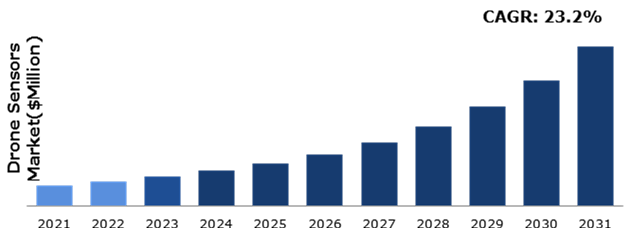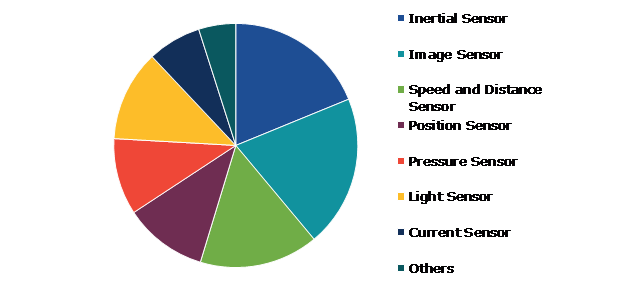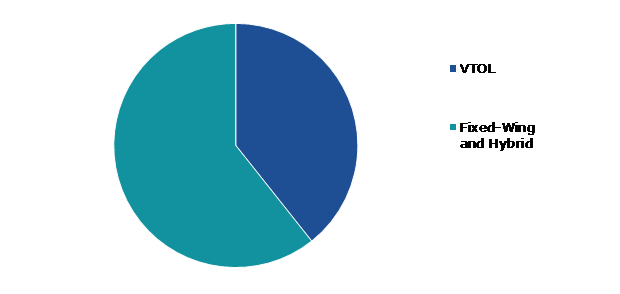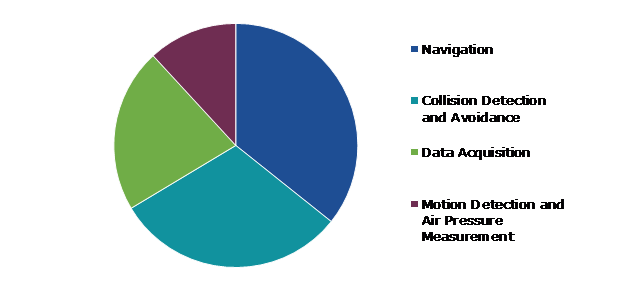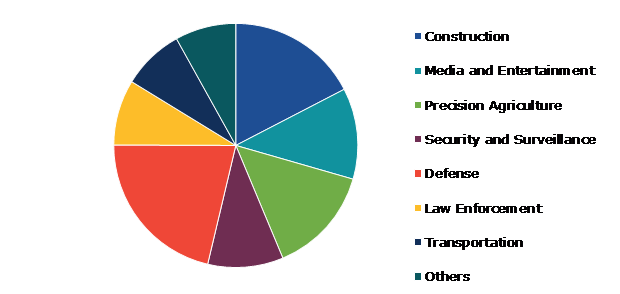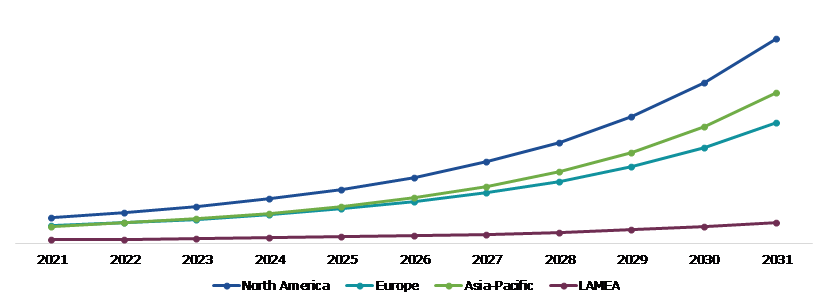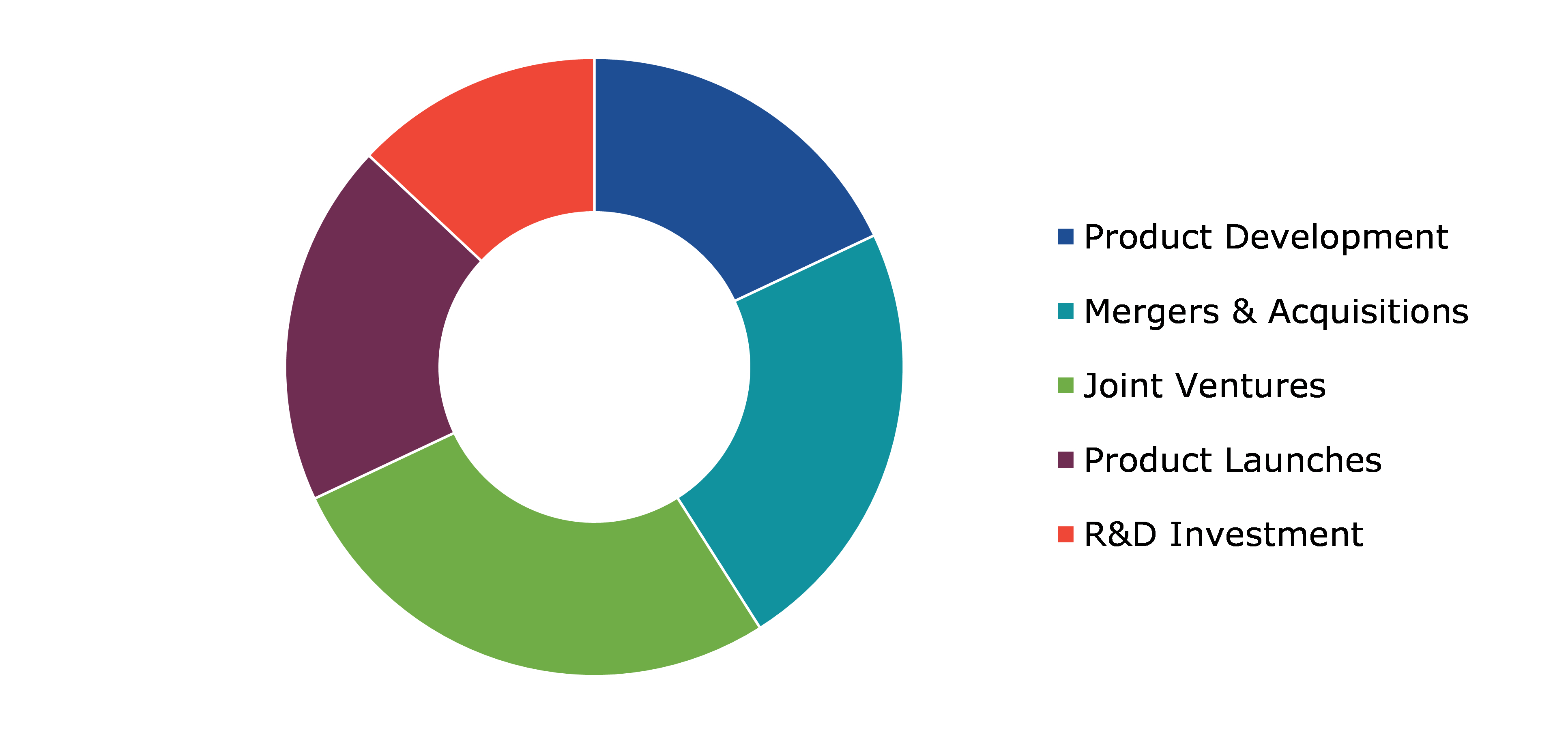Drone Sensors Market Report
RA08667
Drone Sensors Market by Sensors Type (Inertial Sensor, Image Sensor, Speed and Distance Sensor, Position Sensor, Pressure Sensor, Light Sensor, Current Sensor, and Others), Platform Type (VTOL, and Fixed-Wing and Hybrid), Application (Navigation, Collision Detection and Avoidance, Data Acquisition, and Motion Detection and Air Pressure Measurement), End User (Construction, Media and Entertainment, Precision Agriculture, Security and Surveillance, Defense, Law Enforcement, Transportation, and Others), and Regional Analysis (North America, Europe, Asia-Pacific, and LAMEA): Global Opportunity Analysis and Industry Forecast, 2022-2031
Global Drone Sensors Market Analysis
The Global Drone Sensors Market Size was $506.6 million in 2021 and is predicted to grow with a CAGR of 23.2%, by generating a revenue of $3,930.4 million by 2031.
Global Drone Sensors Market Synopsis
Drones are used for mapping, precise positioning, and high-definition imaging. In addition, the widespread use of drones in the agriculture sector for crop growth analysis is thriving the drone sensors industry. Drones are also widely used in the defense sector for intelligence gathering, monitoring, surveillance, search, and rescue operations. The market is growing because of rising military budgets, especially in developing countries. In addition, the increasing use of drones for media and the rising demand for drones to transport payloads are all significantly boosting the drone sensors market growth.
The global regulations that apply to the drone industry have the potential to impede the development of the drone sensors market. In addition, the high cost of drone sensors may act as one of the key factors hampering the growth of the market. Also, drone sensors have limited safety operational performance and need to be recharged at regular intervals. This is also one of the major factors hampering the growth of the market in the upcoming years.
The drone sensors market is anticipated to expand globally owing to the increasing use of artificial intelligence technologies in the drone sensors sector. Many drones are equipped with cutting-edge devices, including LiDAR, sophisticated cameras, GNSS, infrared, and thermal imaging types. Modern Unmanned Aerial Vehicles (UAVs) come with a variety of sensors, including air-to-air missiles, communication reconnaissance devices, and the global mobile communication system (GSM). Modern UAVs are capable of transporting a wide range of payloads installed on internal weapon bays and big sensors. Commercial applications of artificial intelligence are presently found in high-altitude military UAV autonomous flight types. These are the promising market trends for drone sensors that are anticipated to drive market expansion during the forecast period.
According to regional analysis, the Asia-Pacific drone sensors market is anticipated to show the fastest growth during the forecast period. The development of advanced drone sensors and the increase in demand for drones for commercial applications are expected to drive the growth of the market in the region.
Drone Sensors Overview
A drone is a flying robot or aircraft that may be operated remotely or autonomously by software in its integrated system, onboard sensors, and global positioning system. Unmanned aerial vehicles or Unmanned Aircraft Systems (UAS) are other names for drones. In addition, drones are used in almost every field including construction, media & entertainment, precision agriculture, security & surveillance, law enforcement, transportation, traffic and weather monitoring, weddings, and even for service delivery.
COVID-19 Impact on Global Drone Sensors Market
The COVID-19 pandemic has brought several uncertainties leading to severe economic losses as various businesses across the world were at a standstill. This ultimately lowered the demand for drone sensors due to disruptions in the supply chain, closure of manufacturing plants, as well as economic slowdown across several countries. The pandemic has disrupted several supply lines due to the severe lockdown implemented by governments of various countries. These limitations have disrupted the supply-demand connection, impacting the worldwide economy and commerce volume. Therefore, drone technology proved to be most helpful for combating the spread of viruses in public areas. Drones were extensively used for sanitization, medical transportation, blood sample transportation, and public surveillance. Efficient contactless delivery has led to an increase in the demand for drones in the global commercial and government sectors, which is anticipated to boost the drone sensor market development in the post-pandemic period.
Growing Applications of Drone Sensors in the Industrial Sector to Drive the Market Growth
Drone technology is constantly extending its reach in different countries by maximizing the range of business uses drones such as aerial photography, shipping, logistics, and delivery, precision farming, and environmental monitoring. Unmanned systems are widely used in commercial and civil applications due to their superior imaging and security surveillance capabilities. In addition, the increase in demand for drone sensors is expected to drive the growth of the drone sensor market. The use of drone sensors in commercial applications such as agriculture, logistics, and delivery services is expected to increase, creating a need for advanced sensors to enable the drone sensors to perform their intended tasks. In addition, the increase in use of drone sensors in military applications such as surveillance and reconnaissance is expected to further drive the growth of the drone sensor market. The rising demand for unmanned systems is expected to drive global market growth in the future.
To know more about global drone sensors market drivers, get in touch with our analysts here.
Safety Concerns and High Cost Associated with Drone Sensors System to Restrain the Market Growth
Safety and privacy concerns are one of the major obstacles to the development of the global drone sensors industry. Drones also present a serious threat to aircraft as if they come in close contact to an aircraft they can be sucked into the turbines, thereby seriously damaging the propulsion systems. Drone-related privacy and safety issues are anticipated to restrain the development of the target market during the forecast period. Sensor technology is susceptible to severe environmental conditions, rendering drones inoperable in some regions. The sensors system is costly due to complex designs and reliance on other factors. These are the major factors expected to hamper market development during the forecast period.
Increase in Adoption of Technologically Advanced Drone Sensors Across Various Sectors to Drive Excellent Opportunities
The growing use of drone sensors systems in military operations such as intelligence, surveillance, reconnaissance, and targeting, owing to superior automated flight capabilities, is expected to drive market development in the upcoming years. The increase in procurement of UAVs in various countries to modernize the existing fleet, improve military, and defense capabilities for counterinsurgency, counterterrorism, and border crossing is driving the market growth. For surveillance, a wide variety of unmanned systems employ different sensors such as infrared and Lidar. Air pressure sensors to stabilize the body, accelerometers, gyroscopes, and barometric pressure sensors are all widely used to allow smooth precision flight. Increase in artificial intelligence integration in automation technology is anticipated to drive the drone sensors market during the forecast period.
To know more about global drone sensors market opportunities, get in touch with our analysts here.
Global Drone Sensors Market, by Sensors Type
Based on sensors type, the market has been divided into inertial sensor, image sensor, speed and distance sensor, position sensor, pressure sensor, light sensor, current sensor, and others. Among these, the image sensor sub-segment accounted for the highest market share in 2021, whereas the inertial sensor sub-segment is estimated to show the fastest growth during the forecast period.
Global Drone Sensors Market Share, by Sensors Type, 2021
Source: Research Dive Analysis
The image sensor sub-segment accounted for a dominant market share in 2021. The image sensor is anticipated to be driven by the rising investments in security and surveillance in public places all over the globe. There is also a rise in the usage of technology for enhancing anti-terror equipment and reducing security flaws. The image sensor is anticipated to develop in the upcoming years owing to the rise in disposable income and an increase in the adoption of image cameras for automotive applications.
The inertial sensor sub-segment is anticipated to show the fastest growth during the forecast period. Increasing use of micro electromechanical systems (MEMS), rising demand for precise navigation, and growth in the aerospace, commercial, and military sectors of emerging countries are some of the key factors driving the market growth. Also, the global increase in drones and the rise in military spending are responsible for the rising deployment of internal sensing systems.
Global Drone Sensors Market, by Platform Type
Based on platform type, the market has been divided into VTOL, and fixed-wing and hybrid. Among these, the fixed-wing and hybrid sub-segment accounted for highest revenue share in 2021.
Global Drone Sensors Market Size, by Platform Type, 2021
Source: Research Dive Analysis
The fixed-wing and hybrid sub-segment accounted for a dominating market share in 2021. The increasing demand for these aircraft for commercial flight operations, surveying and mapping, imaging, product delivery, and airborne remote sensing in the agricultural, environmental, and defense sectors will further drive the expansion of the fixed-wing and hybrid drone sensors market. Drone sensors have seen technological advancements that have raised demand in the defense industry for essential operations that do not put the lives of military personnel at risk. Drone sensors support border and conflict zone monitoring as well. The development of the fixed-wing and hybrid drone sensors market will be driven by the development of artificial intelligence, big data, and other cutting-edge surveillance systems that will improve the operation and function of these planes. These factors are anticipated to boost the growth of fixed-wing and hybrid sub-segment during the forecast timeframe.
Global Drone Sensors Market, by Application
Based on application, the market has been divided into navigation, collision detection and avoidance, data acquisition, motion detection and air pressure measurement. Among these, the navigation sub-segment accounted for highest revenue share in 2021.
Global Drone Sensors Market Growth, by Application, 2021
Source: Research Dive Analysis
The navigation sub-segment accounted for a dominating market share in 2021. The GPS sensors and navigation system provide precise information such as correct orientation and distances. Advanced mapping and positioning systems are required for emergency uses such as disasters management, search and rescue missions, and remote sensing. The wide adoption of drones for navigation application is expected to drive the segment development.
Global Drone Sensors Market, by End User
Based on end user, the market has been divided into construction, media and entertainment, precision agriculture, security and surveillance, defense, law enforcement, transportation, and others. Among these, the defense sub-segment accounted for the highest revenue share in 2021.
Global Drone Sensors Market Analysis, by End User, 2021
Source: Research Dive Analysis
The defense sub-segment accounted for a dominating market share in 2021. Drones’ sensors have been becoming more common, particularly for border security, counterinsurgency, and commercial property surveillance. Drones sessors or unmanned aerial vehicles can detect security and terrorism-related threats and pinpoint sensitive areas that are subject to a variety of threats. Drones are a contemporary force multiplier that may increase security forces' ability to monitor criminal activity and address emerging difficulties in defense and homeland security.
Global Drone Sensors Market, Regional Insights
The drone sensors market was investigated across North America, Europe, Asia-Pacific, and LAMEA.
Global Drone Sensors Market Size & Forecast, by Region, 2021-2031 (USD Million)
Source: Research Dive Analysis
The Market for Drone Sensors in North America to be the Most Dominant
The North America drone sensors market accounted for a dominating market share in 2021. The high defense budget and the adoption of advanced technology in various sectors are also rapidly driving the growth of the regional market. Military and defense are two other main industries where demand for drone sensors is increasing. Precision farming is a strategy that requires the drone's sensors. Precision farming is becoming more popular in North America, driving the drone sensors market. The oil and gas industry also contributes to the growth of the drone sensor market since drones are required in the oil and gas industry for pipeline inspection.
Competitive Scenario in the Global Drone Sensors Market
Investment and agreement are common strategies followed by major market players. For instance, in October 2021 – Skyports and Kenya Airways announced the signing of a Memorandum of Understanding (MoU) to commence regular Unmanned Aerial Vehicle (UAV) operations in Kenya. The goal of this cooperation is to look into the business impact and feasibility of different logistics, inspection, and medical drones.
Source: Research Dive Analysis
Some of the leading drone sensors market players are Trimble, Bosch Sensortec GmbH, Sparton NavEx, Raytheon, ams AG, Infineon Technologies AG, PrescisionHawk, Sentera, Inc., Slantrange, and TDK Corporation.
| Aspect | Particulars |
| Historical Market Estimations | 2020 |
| Base Year for Market Estimation | 2021 |
| Forecast Timeline for Market Projection | 2022-2031 |
| Geographical Scope | North America, Europe, Asia-Pacific, and LAMEA |
| Segmentation by Sensors Type |
|
| Segmentation by Platform Type |
|
| Segmentation by Application |
|
| Segmentation by End User |
|
| Key Companies Profiled |
|
Q1. What is the size of the global drone sensors market?
A. The size of the global drone sensors market was over $506.6 million in 2021 and is projected to reach $3,930.4 million by 2031.
Q2. Which are the major companies in the drone sensors market?
A. Trimble, Bosch Sensortec GmbH, and Sparton NavEx are some of the key players in the global drone sensors market.
Q3. Which region, among others, possesses greater investment opportunities in the future?
A. Asia-Pacific possesses great investment opportunities for investors to witness the most promising growth in the future.
Q4. What will be the growth rate of the Asia-Pacific drone sensors market?
A. Asia-Pacific drone sensors market is anticipated to grow at 24.8% CAGR during the forecast period.
Q5. What are the strategies opted by the leading players in this market?
A. Agreement and investment are the two key strategies opted by the operating companies in this market.
Q6. Which companies are investing more on R&D practices?
A. Trimble, Bosch Sensortec GmbH, and Sparton NavEx are the companies investing more on R&D activities for developing new products and technologies.
1.Research Methodology
1.1.Desk Research
1.2.Real time insights and validation
1.3.Forecast model
1.4.Assumptions and forecast parameters
1.5.Market size estimation
1.5.1.Top-down approach
1.5.2.Bottom-up approach
2.Report Scope
2.1.Market definition
2.2.Key objectives of the study
2.3.Report overview
2.4.Market segmentation
3.Overview of the impact of COVID-19 on the global drone sensors market
4.Executive Summary
5.Market Overview
5.1.Introduction
5.2.Growth impact forces
5.2.1.Drivers
5.2.2.Restraints
5.2.3.Opportunities
5.3.Market value chain analysis
5.3.1.List of raw material suppliers
5.3.2.List of manufacturers
5.3.3.List of distributors
5.4.Innovation & sustainability matrices
5.4.1.Technology matrix
5.4.2.Regulatory matrix
5.5.Porter’s five forces analysis
5.5.1.Bargaining power of suppliers
5.5.2.Bargaining power of consumers
5.5.3.Threat of substitutes
5.5.4.Threat of new entrants
5.5.5.Competitive rivalry intensity
5.6.PESTLE analysis
5.6.1.Political
5.6.2.Economical
5.6.3.Social
5.6.4.Technological
5.6.5.Environmental
6.Impact of COVID-19 on the Drone Sensors Market
6.1.1.Pre-covid market scenario
6.1.2.Post-covid market scenario
7.Drone Sensors Market Analysis, by Sensors Type
7.1.Overview
7.2.Inertial Sensor
7.2.1.Definition, key trends, growth factors, and opportunities
7.2.2.Market size analysis, by region, 2021-2031
7.2.3.Market share analysis, by country, 2021-2031
7.3.Image Sensor
7.3.1.Definition, key trends, growth factors, and opportunities
7.3.2.Market size analysis, by region, 2021-2031
7.3.3.Market share analysis, by country, 2021-2031
7.4.Speed and Distance Sensor
7.4.1.Definition, key trends, growth factors, and opportunities
7.4.2.Market size analysis, by region, 2021-2031
7.4.3.Market share analysis, by country, 2021-2031
7.5.Position Sensor
7.5.1.Definition, key trends, growth factors, and opportunities
7.5.2.Market size analysis, by region, 2021-2031
7.5.3.Market share analysis, by country, 2021-2031
7.6.Pressure Sensor
7.6.1.Definition, key trends, growth factors, and opportunities
7.6.2.Market size analysis, by region, 2021-2031
7.6.3.Market share analysis, by country, 2021-2031
7.7.Light Sensor
7.7.1.Definition, key trends, growth factors, and opportunities
7.7.2.Market size analysis, by region, 2021-2031
7.7.3.Market share analysis, by country, 2021-2031
7.8. Current Sensor
7.8.1.Definition, key trends, growth factors, and opportunities
7.8.2.Market size analysis, by region, 2021-2031
7.8.3.Market share analysis, by country, 2021-2031
7.9.Others
7.9.1.Definition, key trends, growth factors, and opportunities
7.9.2.Market size analysis, by region, 2021-2031
7.9.3.Market share analysis, by country, 2021-2031
7.10.Research Dive Exclusive Insights
7.10.1.Market attractiveness
7.10.2.Competition heatmap
8.Drone Sensors Market Analysis, by Platform Type
8.1.VTOL
8.1.1.Definition, key trends, growth factors, and opportunities
8.1.2.Market size analysis, by region, 2021-2031
8.1.3.Market share analysis, by country, 2021-2031
8.2.Fixed-Wing and Hybrid
8.2.1.Definition, key trends, growth factors, and opportunities
8.2.2.Market size analysis, by region, 2021-2031
8.2.3.Market share analysis, by country, 2021-2031
8.3.Research Dive Exclusive Insights
8.3.1.Market attractiveness
8.3.2.Competition heatmap
9.Drone Sensors Market Analysis, by Application
9.1.Navigation
9.1.1.Definition, key trends, growth factors, and opportunities
9.1.2.Market size analysis, by region, 2021-2031
9.1.3.Market share analysis, by country, 2021-2031
9.2.Collision Detection and Avoidance
9.2.1.Definition, key trends, growth factors, and opportunities
9.2.2.Market size analysis, by region, 2021-2031
9.2.3.Market share analysis, by country, 2021-2031
9.3.Data Acquisition
9.3.1.Definition, key trends, growth factors, and opportunities
9.3.2.Market size analysis, by region, 2021-2031
9.3.3.Market share analysis, by country, 2021-2031
9.4.Motion Detection and Air Pressure Measurement
9.4.1.Definition, key trends, growth factors, and opportunities
9.4.2.Market size analysis, by region, 2021-2031
9.4.3.Market share analysis, by country, 2021-2031
9.5.Research Dive Exclusive Insights
9.5.1.Market attractiveness
9.5.2.Competition heatmap
10.Drone Sensors Market Analysis, by End User
10.1.Construction
10.1.1.Definition, key trends, growth factors, and opportunities
10.1.2.Market size analysis, by region, 2021-2031
10.1.3.Market share analysis, by country, 2021-2031
10.2.Media and Entertainment
10.2.1.Definition, key trends, growth factors, and opportunities
10.2.2.Market size analysis, by region, 2021-2031
10.2.3.Market share analysis, by country, 2021-2031
10.3.Precision Agriculture
10.3.1.Definition, key trends, growth factors, and opportunities
10.3.2.Market size analysis, by region, 2021-2031
10.3.3.Market share analysis, by country, 2021-2031
10.4.Security and Surveillance
10.4.1.Definition, key trends, growth factors, and opportunities
10.4.2.Market size analysis, by region, 2021-2031
10.4.3.Market share analysis, by country, 2021-2031
10.5.Defense
10.5.1.Definition, key trends, growth factors, and opportunities
10.5.2.Market size analysis, by region, 2021-2031
10.5.3.Market share analysis, by country, 2021-2031
10.6.Law Enforcement
10.6.1.Definition, key trends, growth factors, and opportunities
10.6.2.Market size analysis, by region, 2021-2031
10.6.3.Market share analysis, by country, 2021-2031
10.7.Transportation
10.7.1.Definition, key trends, growth factors, and opportunities
10.7.2.Market size analysis, by region, 2021-2031
10.7.3.Market share analysis, by country, 2021-2031
10.8.Others
10.8.1.Definition, key trends, growth factors, and opportunities
10.8.2.Market size analysis, by region, 2021-2031
10.8.3.Market share analysis, by country, 2021-2031
10.9.Research Dive Exclusive Insights
10.9.1.Market attractiveness
10.9.2.Competition heatmap
11.Drone Sensors Market, by Region
11.1.North America
11.1.1.U.S.
11.1.1.1.Market size analysis, by Sensors Type, 2021-2031
11.1.1.2.Market size analysis, by Platform Type, 2021-2031
11.1.1.3.Market size analysis, by Application, 2021-2031
11.1.1.4.Market size analysis, by End User, 2021-2031
11.1.2.Canada
11.1.2.1.Market size analysis, by Sensors Type, 2021-2031
11.1.2.2.Market size analysis, by Platform Type, 2021-2031
11.1.2.3.Market size analysis, by Application, 2021-2031
11.1.2.4.Market size analysis, by End User, 2021-2031
11.1.3.Mexico
11.1.3.1.Market size analysis, by Sensors Type, 2021-2031
11.1.3.2.Market size analysis, by Platform Type, 2021-2031
11.1.3.3.Market size analysis, by Application, 2021-2031
11.1.3.4.Market size analysis, by End User, 2021-2031
11.1.4.Research Dive Exclusive Insights
11.1.4.1.Market attractiveness
11.1.4.2.Competition heatmap
11.2.Europe
11.2.1.Germany
11.2.1.1.Market size analysis, by Sensors Type, 2021-2031
11.2.1.2.Market size analysis, by Platform Type, 2021-2031
11.2.1.3.Market size analysis, by Application, 2021-2031
11.2.1.4.Market size analysis, by End User, 2021-2031
11.2.2.UK
11.2.2.1.Market size analysis, by Sensors Type, 2021-2031
11.2.2.2.Market size analysis, by Platform Type, 2021-2031
11.2.2.3.Market size analysis, by Application, 2021-2031
11.2.2.4.Market size analysis, by End User, 2021-2031
11.2.3.France
11.2.3.1.Market size analysis, by Sensors Type, 2021-2031
11.2.3.2.Market size analysis, by Platform Type, 2021-2031
11.2.3.3.Market size analysis, by Application, 2021-2031
11.2.3.4.Market size analysis, by End User, 2021-2031
11.2.4.Spain
11.2.4.1.Market size analysis, by Sensors Type, 2021-2031
11.2.4.2.Market size analysis, by Platform Type, 2021-2031
11.2.4.3.Market size analysis, by Application, 2021-2031
11.2.4.4.Market size analysis, by End User, 2021-2031
11.2.5.Italy
11.2.5.1.Market size analysis, by Sensors Type, 2021-2031
11.2.5.2.Market size analysis, by Platform Type, 2021-2031
11.2.5.3.Market size analysis, by Application, 2021-2031
11.2.5.4.Market size analysis, by End User, 2021-2031
11.2.6.Rest of Europe
11.2.6.1.Market size analysis, by Sensors Type, 2021-2031
11.2.6.2.Market size analysis, by Platform Type, 2021-2031
11.2.6.3.Market size analysis, by Application, 2021-2031
11.2.6.4.Market size analysis, by End User, 2021-2031
11.2.7.Research Dive Exclusive Insights
11.2.7.1.Market attractiveness
11.2.7.2.Competition heatmap
11.3.Asia-Pacific
11.3.1.China
11.3.1.1.Market size analysis, by Sensors Type, 2021-2031
11.3.1.2.Market size analysis, by Platform Type, 2021-2031
11.3.1.3.Market size analysis, by Application, 2021-2031
11.3.1.4.Market size analysis, by End User, 2021-2031
11.3.2.Japan
11.3.2.1.Market size analysis, by Sensors Type, 2021-2031
11.3.2.2.Market size analysis, by Platform Type, 2021-2031
11.3.2.3.Market size analysis, by Application, 2021-2031
11.3.2.4.Market size analysis, by End User, 2021-2031
11.3.3.India
11.3.3.1.Market size analysis, by Sensors Type, 2021-2031
11.3.3.2.Market size analysis, by Platform Type, 2021-2031
11.3.3.3.Market size analysis, by Application, 2021-2031
11.3.3.4.Market size analysis, by End User, 2021-2031
11.3.4.Australia
11.3.4.1.Market size analysis, by Sensors Type, 2021-2031
11.3.4.2.Market size analysis, by Platform Type, 2021-2031
11.3.4.3.Market size analysis, by Application, 2021-2031
11.3.4.4.Market size analysis, by End User, 2021-2031
11.3.5.South Korea
11.3.5.1.Market size analysis, by Sensors Type, 2021-2031
11.3.5.2.Market size analysis, by Platform Type, 2021-2031
11.3.5.3.Market size analysis, by Application, 2021-2031
11.3.5.4.Market size analysis, by End User, 2021-2031
11.3.6.Rest of Asia-Pacific
11.3.6.1.Market size analysis, by Sensors Type, 2021-2031
11.3.6.2.Market size analysis, by Platform Type, 2021-2031
11.3.6.3.Market size analysis, by Application, 2021-2031
11.3.6.4.Market size analysis, by End User, 2021-2031
11.3.7.Research Dive Exclusive Insights
11.3.7.1.Market attractiveness
11.3.7.2.Competition heatmap
11.4.LAMEA
11.4.1.Brazil
11.4.1.1.Market size analysis, by Sensors Type, 2021-2031
11.4.1.2.Market size analysis, by Platform Type, 2021-2031
11.4.1.3.Market size analysis, by Application, 2021-2031
11.4.1.4.Market size analysis, by End User, 2021-2031
11.4.2.Saudi Arabia
11.4.2.1.Market size analysis, by Sensors Type, 2021-2031
11.4.2.2.Market size analysis, by Platform Type, 2021-2031
11.4.2.3.Market size analysis, by Application, 2021-2031
11.4.2.4.Market size analysis, by End User, 2021-2031
11.4.3.UAE
11.4.3.1.Market size analysis, by Sensors Type, 2021-2031
11.4.3.2.Market size analysis, by Platform Type, 2021-2031
11.4.3.3.Market size analysis, by Application, 2021-2031
11.4.3.4.Market size analysis, by End User, 2021-2031
11.4.4.South Africa
11.4.4.1.Market size analysis, by Sensors Type, 2021-2031
11.4.4.2.Market size analysis, by Platform Type, 2021-2031
11.4.4.3.Market size analysis, by Application, 2021-2031
11.4.4.4.Market size analysis, by End User, 2021-2031
11.4.5.Rest of LAMEA
11.4.5.1.Market size analysis, by Sensors Type, 2021-2031
11.4.5.2.Market size analysis, by Platform Type, 2021-2031
11.4.5.3.Market size analysis, by Application, 2021-2031
11.4.5.4.Market size analysis, by End User, 2021-2031
11.4.6.Research Dive Exclusive Insights
11.4.6.1.Market attractiveness
11.4.6.2.Competition heatmap
12.Competitive Landscape
12.1.Top winning strategies, 2021
12.1.1.By strategy
12.1.2.By year
12.2.Strategic overview
12.3.Market share analysis, 2021
13.Company Profiles
13.1.Trimble
13.1.1.Overview
13.1.2.Business segments
13.1.3.Product portfolio
13.1.4.Financial performance
13.1.5.Recent developments
13.1.6.SWOT analysis
13.2.Bosch Sensortec GmbH
13.2.1.Overview
13.2.2.Business segments
13.2.3.Product portfolio
13.2.4.Financial performance
13.2.5.Recent developments
13.2.6.SWOT analysis
13.3.Sparton NavEx
13.3.1.Overview
13.3.2.Business segments
13.3.3.Product portfolio
13.3.4.Financial performance
13.3.5.Recent developments
13.3.6.SWOT analysis
13.4.Raytheon
13.4.1.Overview
13.4.2.Business segments
13.4.3.Product portfolio
13.4.4.Financial performance
13.4.5.Recent developments
13.4.6.SWOT analysis
13.5.ams-OSRAM AG
13.5.1.Overview
13.5.2.Business segments
13.5.3.Product portfolio
13.5.4.Financial performance
13.5.5.Recent developments
13.5.6.SWOT analysis
13.6.Infineon Technologies AG
13.6.1.Overview
13.6.2.Business segments
13.6.3.Product portfolio
13.6.4.Financial performance
13.6.5.Recent developments
13.6.6.SWOT analysis
13.7.PrescisionHawk
13.7.1.Overview
13.7.2.Business segments
13.7.3.Product portfolio
13.7.4.Financial performance
13.7.5.Recent developments
13.7.6.SWOT analysis
13.8. Sentera, Inc.
13.8.1.Overview
13.8.2.Business segments
13.8.3.Product portfolio
13.8.4.Financial performance
13.8.5.Recent developments
13.8.6.SWOT analysis
13.9.Slantrange
13.9.1.Overview
13.9.2.Business segments
13.9.3.Product portfolio
13.9.4.Financial performance
13.9.5.Recent developments
13.9.6.SWOT analysis
13.10.TDK Corporation
13.10.1.Overview
13.10.2.Business segments
13.10.3.Product portfolio
13.10.4.Financial performance
13.10.5.Recent developments
13.10.6.SWOT analysis
Drones have rapidly evolved from being mere toys or gadgets for enthusiasts into powerful tools that are reshaping industries across the globe. One of the key factors driving this transformation is the wide array of sensors that enable drones to gather valuable data, capture high-resolution images, and perform once-unimaginable tasks. There exist different types of drone sensors that are used purposefully across various sectors, from agriculture and infrastructure to disaster management and beyond. For instance, image sensors capture visual data, allowing drones to capture stunning aerial imagery and videos. Similarly, thermal sensors are designed to detect heat leaks in buildings, locate missing persons in dark or obstructed areas, and even assess crop health by identifying variations in plant temperature. On the other hand, LiDAR-equipped drones are widely used across industries such as construction, urban planning, and forestry. They can capture detailed elevation models that can monitor the progress of construction projects and generate precise digital terrain models. Additionally, there are gas and chemical sensors that are widely used in environmental monitoring, industrial inspections, and disaster management.
Forecast Analysis of the Global Drone Sensors Market
According to the report published by Research Dive, the global drone sensors market is predicted to generate a revenue of $3,930.4 million and rise at a fascinating CAGR of 23.2% over the analysis timeframe from 2022 to 2031.
The rising applications of drone sensors for various commercial applications such as logistics, agriculture, and delivery services are expected to foster the growth of the drone sensors market over the analysis timeframe. Moreover, the increasing use of drone sensor systems in military operations such as surveillance, intelligence, reconnaissance, and many more due to the greater automated flight capabilities is expected to create immense growth opportunities over the forecast timeframe. However, the safety concerns and high cost associated with drone sensors system may impede the growth of the market throughout the estimated period.
The major players of the drone sensors market include TDK Corporation, Trimble, Slantrange, Bosch Sensortec GmbH, Sentera, Inc., Sparton NavEx, PrecisionHawk, Raytheon, Infineon Technologies AG, ams-OSRAM AG, and many more.
Drone Sensors Market Developments
The key companies operating in the industry are adopting various growth strategies & business tactics such as partnerships, collaborations, mergers & acquisitions, and launches to maintain a robust position in the overall market, which is subsequently helping the global drone sensors market to grow exponentially. For instance:
- In July 2022, Edge Impulse, the edge AI platform for enterprise teams building innovative products announced that its machine learning development platform would support Bosch Sensortec, a leading MEMS technology specialist to develop a new product namely, The Nicla Sense ME, a microcontroller board. This product is designed to accelerate the development of intelligent sensing solutions.
- In February 2023, MapmyIndia, a leading Indian technology company announced its acquisition of Indrones Solutions Private Limited, a leading innovative company focusing on customer problem-solving solutions. With this acquisition, the companies aimed to set up drone airspace maps and develop location-based software services and AI solutions for various technological applications.
- In May 2023, Trillium Engineering, a leading manufacturer of gimbal imaging systems for unmanned aircraft systems announced its partnership with SightX, a renowned company specializing in edge artificial intelligence (AI). With this partnership, Trillium Engineering aimed to expand its data products offering and improve customers’ abilities to perform ISR missions.
Most Profitable Region
The North America region of the drone sensors market held the highest revenue in 2021. This is mainly due to the high budget plan for the defense sector and the growing adoption of advanced technology in various sectors across the region. Moreover, the increasing demand for drone sensors in the oil and gas industry in the region is predicted to boost the regional growth of the market over the estimated timeframe.
Covid-19 Impact on the Global Drone Sensors Market
The outbreak of the Covid-19 pandemic has caused severe economic losses due to the stagnancy of various industries. It has also hampered the growth of the drone sensors market owing to the closure of manufacturing facilities and disruption in supply chains. However, the increased demand for drones in the commercial and government sectors for various activities such as public surveillance, sanitization, and many more has created numerous growth opportunities for the market over the crisis period.
Personalize this research
- Triangulate with your own data
- Request your format and definition
- Get a deeper dive on a specific application, geography, customer or competitor
- + 1-888-961-4454 Toll - Free
- support@researchdive.com

